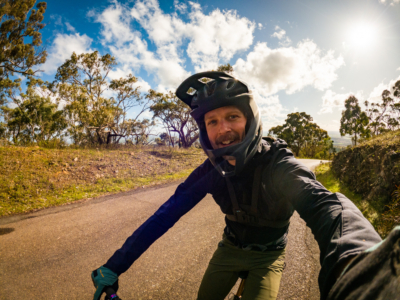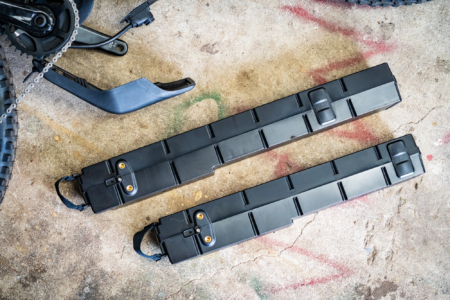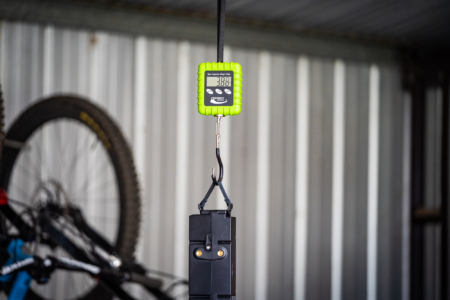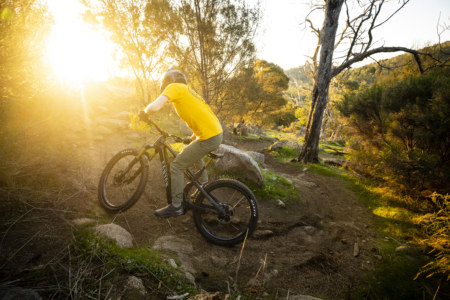Wil reviews the Canyon Spectral:ON
Released earlier this year, the new Canyon Spectral:ON arrived with the promise of both lower weight and improved range over its predecessor. To achieve this, Canyon has developed an all-new carbon frame that will accommodate either a 720Wh or 900Wh battery. There have also been a number of updates to the geometry too, with the Spectral:ON becoming notably slacker and longer. This left us a little wary however. We were already big fans of the previous Spectral:ON, which remains as one of the most lively and fun-handling e-MTBs we’ve ever tested. Would the new model live up to the expectations? And how would its performance compare to the competition?
Watch our Canyon Spectral:ON video review here:
With its full carbon frame, updated geometry and the option of two different batteries, the Canyon Spectral:ON is no doubt a more versatile and more capable bike than its predecessor.

An overview of the Canyon Spectral:ON
First introduced back in 2018, the Canyon Spectral:ON has been evolving at a far more rapid rate compared to any other Canyon mountain bike. Just four years later, this latest version already represents the 4th generation of the electric all-rounder, highlighting the speedy pace of development in the e-MTB landscape.
Compared to its predecessor, which used an alloy back end, the new Spectral:ON is now a full carbon affair. It’s available in both CF and CFR variants, with the latter using higher-modulus fibres to reduce frame weight by 300g.
It carries on with the Shimano EP8 motor, and it continues to use a mullet setup with a 29in front wheel and a 27.5in rear wheel. It also features the same four-bar suspension layout, with an alloy yoke driving the rear shock. The kinematics have been updated however, with rear travel bumping up slightly to 155mm. Canyon matches this with a 150mm travel fork, though the frame will handle up to 160mm.
Those specs put the Spectral:ON in a similar space to other mid-travel e-MTBs like the Specialized Levo, Merida eOne-Sixty and Santa Cruz Heckler MX. Featuring less aggressive geometry, these bikes are designed to be versatile, playful and easy to ride for a wide range of mountain bikers. If it’s more of a hardcore, self-shuttling DH bike you’re after, check out the burlier, heavier and longer travel Torque:ON.
Canyon Spectral:ON price & specs
There are five models in the Canyon Spectral:ON lineup; three that utilise the CF frame and two that use the high-end CFR frame. All models are available with your choice of a 720Wh or 900Wh battery, with the larger capacity option adding a few hundred bucks to the sticker price.
The cheapest option is the Spectral:ON CF 7 that starts at $8,899 AUD. The range then tops out at $17,699 AUD for the Spectral:ON CFR LTD. As always with Canyon, you’ll need to add on the cost of shipping to those prices.
For a detailed overview of the range, including more information on specs, geometry and pricing, see our detailed first look story.
Here we’ll be diving into our experience of testing the second model from the top; the Canyon Spectral:ON CFR.

2022 Canyon Spectral:ON CFR
- Frame | CFR Carbon Fibre, Four Bar Suspension Design, 155mm Travel
- Fork | Fox 36, Factory Series, GRIP2 Damper, 44mm Offset, 150mm Travel
- Shock | Fox Float X, Factory Series, 230x60mm
- Drive Unit | Shimano EP8, 85Nm
- Battery | Canyon 720Wh or 900Wh
- Wheels | Reynolds TRE 309/367, Carbon Rims, Inner Width: 30mm Front & 36mm Rear
- Tyres | Maxxis Assegai EXO 3C Maxx Terra 29×2.5in Front & Minion DHR II EXO+ 3C Maxx Terra 27.5×2.6in Rear
- Drivetrain | Shimano XTR 1×12 w/Shimano EM900 Crankset & 10-51T Cassette
- Brakes | Shimano XTR 4-Piston w/203mm Rotors
- Bar | Canyon Alloy Riser, Width: 760mm (S), 780mm (M-XL)
- Stem | Canyon G5 Alloy, 40mm Length
- Grips | Canyon Lock-On
- Seatpost | Fox Transfer Factory, Travel: 125mm (S), 150mm (M), 170mm (L-XL)
- Saddle | Fizik Terra Aidon X5
- Confirmed Weight | 21.92kg (720Wh Battery)
- RRP | $14,649 AUD (720Wh Battery)
Indeed it’s this marvellous balance of being both poppy and plush that makes the Spectral:ON so impressive

Canyon Spectral:ON size & fit
As with the previous model, I elected for the Medium size in the Canyon Spectral:ON CFR to suit my 175cm height. The general proportions don’t feel too far different, but the geometry has shifted considerably.
For starters, the reach has grown from 445mm to 460mm. Canyon has balanced this out by building the new Spectral:ON around a shorter 40mm stem, and by steepening the seat angle by two whole degrees. Now at 76.5°, there’s no longer any need to shunt the saddle all the way forwards on its rails.
Despite the steeper seat angle however, I haven’t found there to be excessive pressure on my hands. This is due to Canyon increasing the stack height by almost 20mm, which has lifted the front end. The result of all those changes is a more centralised riding position that is still comfortable on the flats, but feels far more stable on steeper climbs.
Unfortunately the seat tube does remain on the long side. And since the Medium frame only comes with a 150mm dropper, I found myself regularly catching the edges of the wide Fizik saddle on steep descents. The saddle itself is very comfortable though, with its ramped tail offering a slip-free platform during seated climbing. I can’t say the same for the overly-firm Canyon grips however, which I promptly swapped out for a set of softer Ergon GE1s.

Suspension & tyre setup
I set up the rear suspension on the Spectral:ON with 30% sag, which equates to 18mm of displacement at the O-ring. For my 68kg riding weight, I needed 170psi inside the Float X shock, and I set the rebound damping halfway at 7/15 clicks. I left the external compression dial fully open for maximum plushness.
Having spent a load of time on the new Fox 36 over the past couple of months, I set it to my usual preference with 78psi and two volume spacers. I run the rebound damping on the faster side, and with the compression dials a little lighter than halfway.
With Canyon spec’ing a relatively lightweight EXO+ casing for the Minion DHR II tyre, I made sure to fit a CushCore Plus insert into the rear wheel before hitting the dirt. Pressures throughout the test period ranged from 20-22psi up front and 25-26psi for the rear.

Canyon Spectral:ON weight
With the 720Wh battery, our Canyon Spectral:ON CFR test bike clocked in at 21.92kg. That’s without pedals or CushCore, but with plenty of tubeless sealant in both tyres.
The sub-22kg weight is impressive, and it makes the Spectral:ON one of the lightest full-powered e-MTBs we’ve tested. The tyre spec certainly helps, as does the choice of a Fox 36 over the burlier and heavier 38. The CFR model also features carbon Reynolds wheels, which came in at a respectable 1,958g on the workshop scales.
Speaking of weight, it’s worth noting that the 900Wh battery is almost a kilo heavier than the 720Wh battery (4.78kg vs 3.88kg). Of course you get more range from the bigger battery, but the added mass also has an affect on handling. More on that in a bit.

What does the Canyon Spectral:ON do well?
Having loved the lively character of the old Canyon Spectral:ON, I’m happy to report that the new model is still an absolute hoot to ride, while being a better balanced bike overall.
Thanks to its updated geometry, the new Spectral:ON is noticeably more planted on the descents. The head angle is a full degree slacker at 65.5°, and that’s paired to a shorter 44mm fork offset. The result of the increased trail is a much calmer feel to the steering, with less twitchiness at speed. Along with the longer reach and the aggressive Assegai tyre, the front end produces more grip and stability, allowing you to push harder with greater confidence.
Weight distribution has also improved. The chainstays were very short on the old bike, which made it insanely carveable, but also made it feel like you were always right over the rear wheel. Canyon has only increased the rear centre length by 5mm, but along with the 3mm lower BB and longer front end, your riding position is more centralised within the overall wheelbase.

As we’ve seen on some other e-MTBs, the EP8 drive unit has been clocked upwards on the Spectral:ON, which allows the battery to sit much lower down. Furthermore, the Canyon-developed battery stacks its cells horizontally, which results in a wide downtube but also a relatively short battery. This helps to concentrate the bike’s centre of mass lower down and closer to the BB.
The culmination of the Spectral:ON’s refined geometry and well-placed mass is tremendous agility. Entering corners does require a bit more angulation than the old bike, but once you’ve calibrated to the commitment point, it rips corners beautifully. The 27.5in rear wheel helps with the sharp turn-in, while the full carbon chassis, with its beefy back end and oversized pivot axles, is super stiff and responsive.
Because of this, the high-volume rear tyre can feel a bit soft when you’re pushing hard. It’s also less likely to dig into loose surfaces, where it tends to float over the top and feel a little vague. But for the most part the tyres deliver excellent traction and damping, allowing you to make the most of the bike’s excellent cornering abilities.

The suspension is also brilliant, being one of the biggest standout attributes of the new Spectral:ON. Canyon has deliberately designed the kinematic around a low anti-squat value (around 60% at sag), which reduces feedback between the drivetrain and the rear suspension. The result is great small-bump sensitivity, with a floaty and comfortable ride quality that helps to generate terrific grip on rough terrain.
And thanks to the Float X shock with its larger bottom-out bumper, there is also noticeably more progression over the old bike. This gives the Spectral:ON a heap more support, with a nicely controlled ramp-up towards the end of the travel. I made use of full travel on plenty of occasions, but it was always a soft and comforting experience.
Indeed it’s this marvellous balance of being both poppy and plush that makes the Spectral:ON so impressive. It’s a difficult attribute to achieve on an e-MTB, where you want the suspension to be active enough to maintain comfort and momentum during seated pedalling efforts on choppy climbs, without feeling like a mashed potato on the descents. The Spectral:ON manages to hit the mark however, offering useful support that allows it to take the harder and bigger hits in its stride.
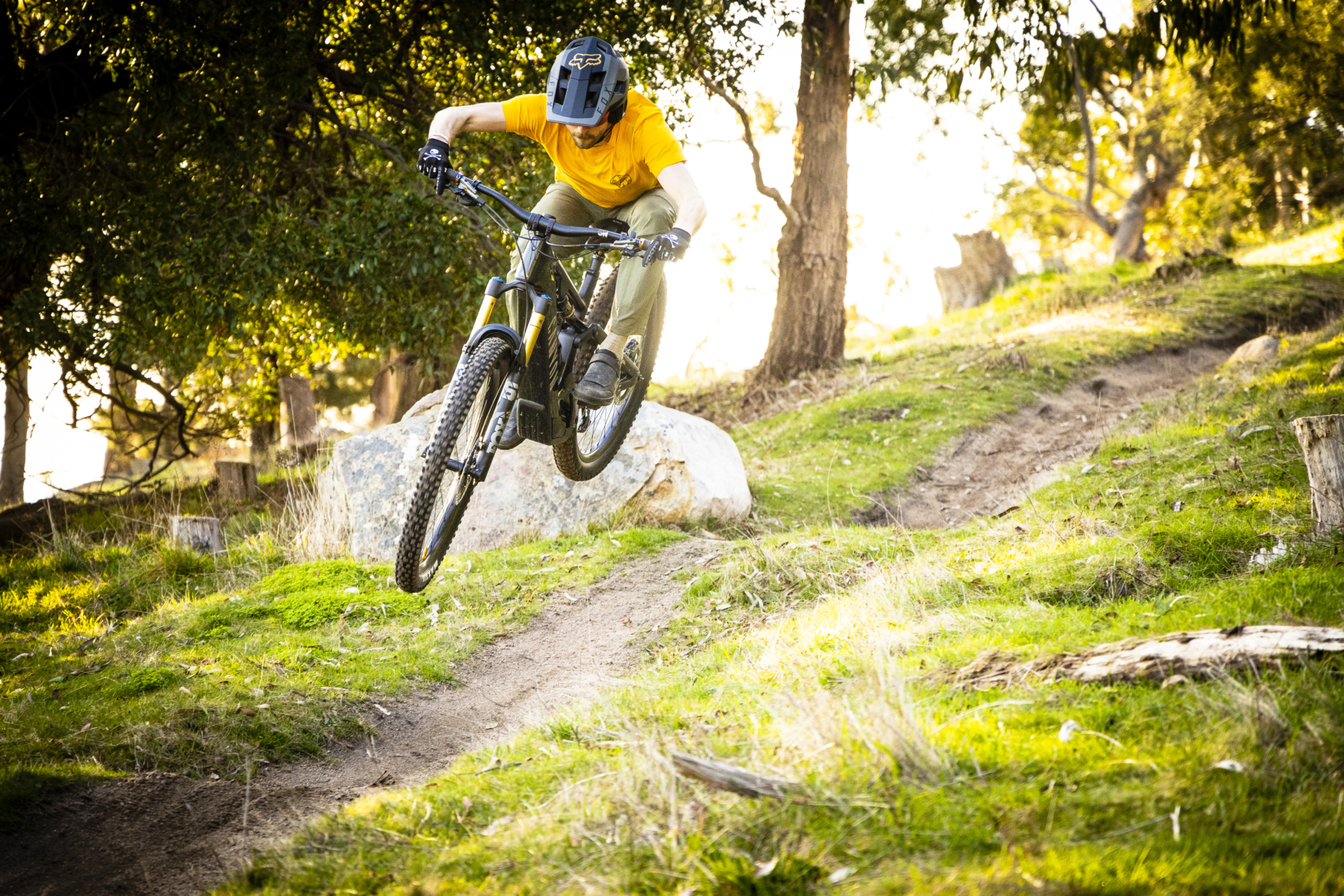
What didn’t we like?
Having come straight off testing the Trek Fuel EXe, I found the motor and chassis noise of the Canyon Spectral:ON to be somewhat jarring. The EP8 motor exhibits a high-pitched whine on the climbs, and it suffers from the well-known clacking noise on the descents, which seems to echo through the cavernous carbon frame. You soon get used to these noises and tune them out, but having thoroughly enjoyed the blissful near-silence of the Trek’s TQ motor, it’s hard to go back.
I also found the EP8 motor to exhibit more surging in its power delivery during turbulent pedalling on awkward tech climbs. I’ll point out here that this is something I’m more likely to notice as a lighter rider. I find the Boost setting to be way too hectic for riding up proper singletrack, and even the stock Trail setting can feel a little unwieldy when things get steep and ledgy.
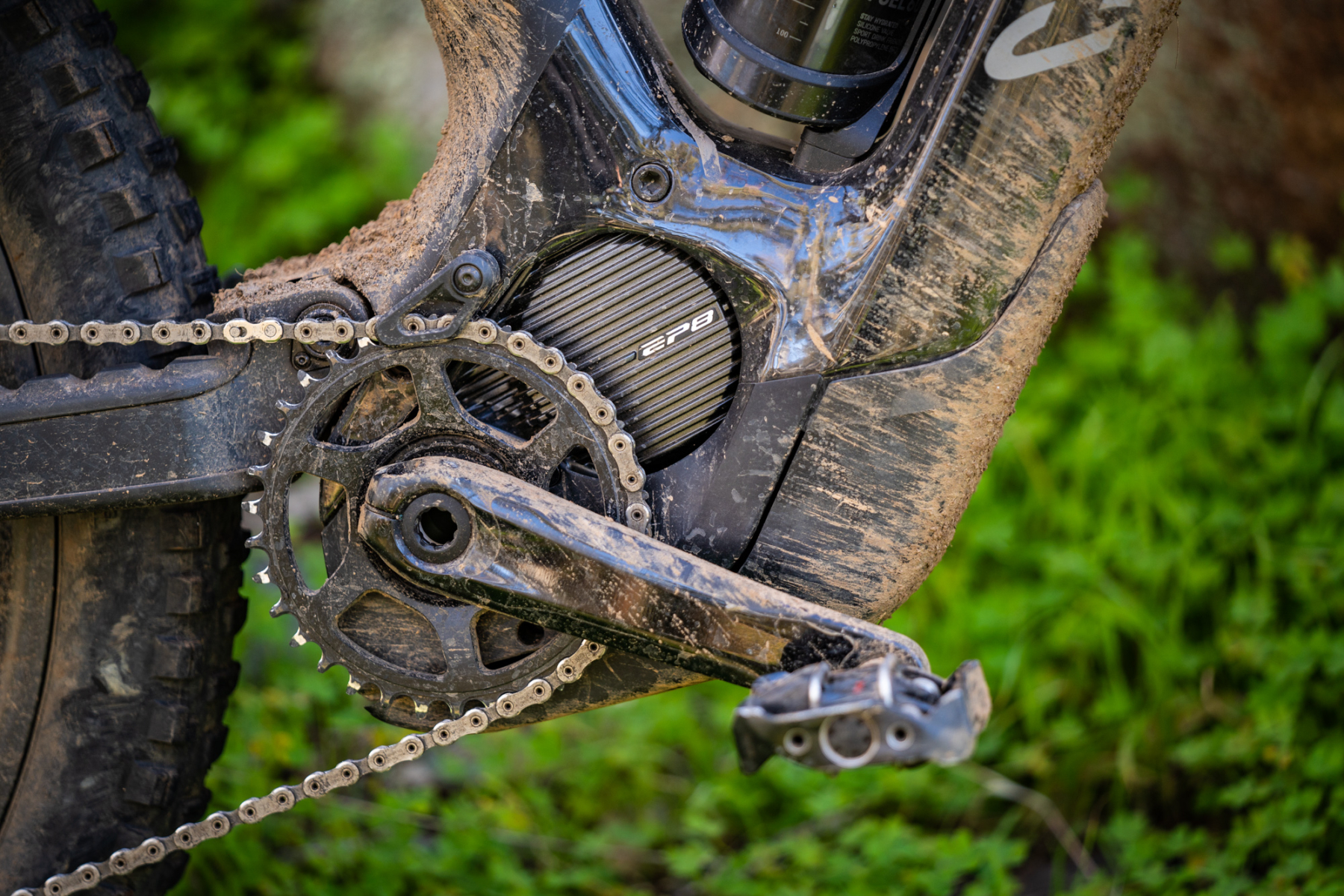
Of course you can tune the EP8 motor via the E-TUBE app, and dialling down the Acceleration Response and Assist Character helps to soften the motor’s punch. Still, when it comes to full-powered motors, in our experience both the Bosch and Brose alternatives deliver a more seamless and predictable feel.
While I’m on the Shimano system, I did encounter an annoying failure during a motor firmware update. You can perform updates at home via the app, but if the connection severs partway through the update (say if your phone signal drops out), the system switches off and will no longer turn on. Having missed my planned ride due to a dead motor, I then had to take the bike into a local shop to be plugged into Shimano’s dealer program for the firmware to be reinstalled. Not the end of the world, but frustrating nonetheless.
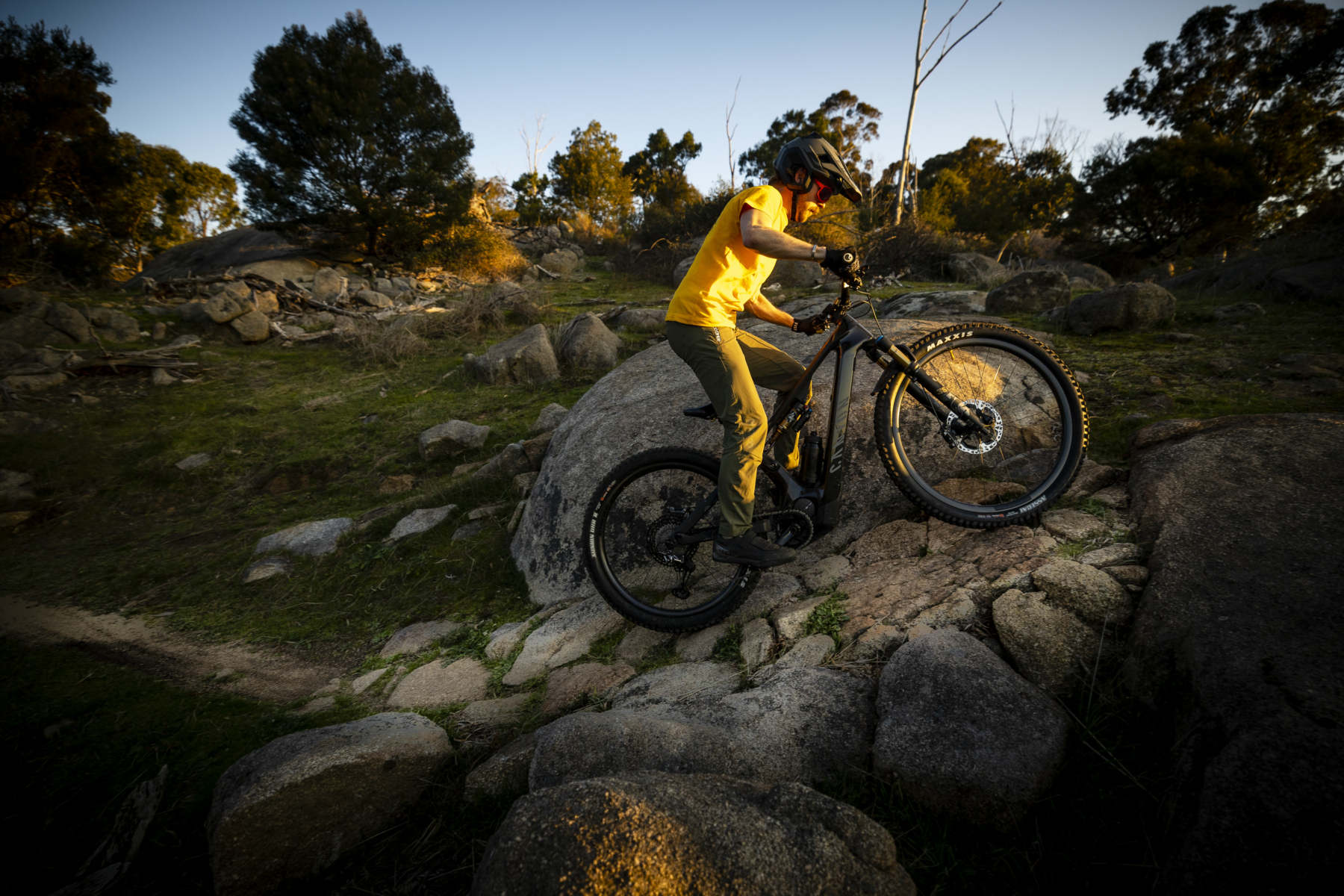
Otherwise I’ve little to complain about when it comes to the ride quality of the Spectral:ON. As well as being a better bike on the descents, it’s also more comfortable on the climbs. The steeper seat angle and longer chainstays help here, and so too does the more supportive suspension that rides higher in its travel. There’s less wallow from the shock, so although the static BB height is a little closer to the ground, I’ve actually encountered way fewer pedal strikes compared to the old bike.
The mullet setup does result in less rollover compared to a full 29er though, so it can be harder to maintain grip and momentum when the climbs (and descents) get obscenely gnarly. This characteristic will be exacerbated for taller riders, who may find the 440mm rear centre length to be too short.
Those riders who are chasing outright stability will likely be better served by looking at a 29er e-MTB with a longer rear end, such as the Norco Sight VLT and Trek Rail. Of course the reason you’d be looking at the Spectral:ON in the first place is for its playful ride quality, and in that regard the mullet setup delivers by the bucketload.

How much range can you get?
To see what would be possible in terms of range, I’ve been testing the Canyon Spectral:ON with both the 720Wh and 900Wh battery options. Swapping batteries is a quick process, as you only need to unhook the skid plate and take out the two anchor bolts before the battery can slide straight out of the downtube. This means you can charge the battery separately if needed.
On my biggest ride with the 720Wh battery, I ran it flat after riding close to 50km of singletrack with 1,545m of elevation gain. With the 900Wh battery, I notched up over 60km with 1,875m of elevation gain. Both of these rides were with the motor in the stock Trail setting.
I also put the Spectral:ON through our standardised range test to see how it would compare directly with some of the other e-MTBs we’ve reviewed lately. This test involves riding up a road climb with the motor set to the most powerful assist setting, before heading back down a variety of singletrack descents to see how many laps I could get achieve from a single charge.
It’s worth pointing out that the tarmac climb does result in less resistance compared to riding off-road, so I always end up with more elevation gain compared to riding on pure singletrack. However, it’s far more consistent and repeatable, allowing me to minimise the variables between bikes to achieve a useful comparison.
With that in mind, here’s how the Spectral:ON fared with its big 900Wh battery;
- Norco Sight VLT (Shimano EP8, 900Wh Battery) – 2,478m climbing (12.8 runs)
- Canyon Spectral:ON (Shimano EP8, 900Wh Battery) – 2,451m climbing (12.7 runs)
- Rocky Mountain Altitude Powerplay (Dyname 4.0, 720Wh Battery) – 2,108m climbing (10.9 runs)
- Cube Stereo Hybrid 160 (Bosch Gen 4, 625Wh Battery) – 1,800m climbing (9.3 runs)
- Orbea Rise (Shimano EP8-RS, 360Wh Battery) – 1,388m climbing (7.2 runs)
- Specialized Levo SL (SL 1.1, 320Wh Battery) – 1,377m climbing (7.1 runs)
- Trek Fuel EXe (TQ-HPR50, 360Wh Battery) – 1,312m climbing (6.8 runs)
- Specialized Kenevo SL (SL 1.1, 320Wh Battery) – 1,053m climbing (5.5 runs)

As you can see from that list, the Spectral:ON racked up an enormous amount of riding. It ended up just shy of 2,500m of elevation gain, which was very similar to the Norco Sight VLT. Given the Spectral:ON is a little lighter and fitted with faster-rolling tyres, I would have expected it to have gone a little further.
There are some other variables that have probably affected the outcome. Ambient temperature can affect the performance of both the motor and battery, and general battery health can vary depending on how it’s been stored and charged. The biggest variable however, will be the rider. How smoothly you pedal and maintain a consistent speed will affect the motor’s efficiency, so ridden on a different day, I wouldn’t be surprised to see the Sight VLT and Spectral:ON trading places.
720Wh or 900Wh battery?
It’s great to see the Canyon Spectral:ON offered with two different batteries, though which one should you go for?
The 900Wh battery obviously gets you more range, so if you’re regularly hitting up big rides in the mountains with maximum elevation gain, then the extra capacity makes sense. Boost-addicts and heavier riders are also likely to appreciate the 900Wh battery, which pretty much eliminates range anxiety. Not having to charge up the battery after every ride is also a nice luxury.
The downside of the 900Wh battery, aside from costing more, is that it adds nearly a kilo in extra weight. That in itself isn’t a huge deal, but the fact that the extra mass is concentrated high on the bike up at the head tube does make it noticeable.
With the big battery fitted, I found it was harder to pick up the front wheel over obstacles on the trail.
With the big battery fitted, I found it was harder to pick up the front wheel over obstacles on the trail. The bike generally felt more grounded overall, with the extra weight sacrificing some of the Spectral:ON’s agility when things got fast and twisty.
Personally, as a lighter rider, I much prefer the handling with the 720Wh battery. The bike is more nimble and better balanced, and the 720Wh battery offers a good deal of range that’ll satisfy most rider’s needs.
In fact, I’d even consider a smaller 400-500Wh battery option if Canyon offered it. That would allow the Spectral:ON to get closer to 20kg, and it would help to lower the centre of mass even further. I’m not holding my breath though, as there’s clearly a much smaller market for a full-powered e-MTB with a battery of that size. I reckon it’s far more likely that Canyon is already working on a dedicated lightweight e-MTB to compete with the likes of the Fuel EXe, Levo SL and Rise, which is something we’d be very interested to see.

Component highs & lows
As you’d expect for the not-inconsiderable price tag, the Canyon Spectral:ON CFR offers an impressive and mostly desirable spec.
While I would like to see a longer dropper, I’ve zero complaints from the Shimano XTR groupset, which has delivered fantastic shifting under power and solid braking performance.
The Reynolds wheels have been similarly fuss-free, and the wide rims provide an excellent platform for the versatile Maxxis tyre combo. Personally, I’d run a softer MaxxGrip tyre up front when the stock Assegai wears out, and more aggressive riders will benefit from fitting a heavier DoubleDown tyre on the back. That said, I actually liked the supple ride and damping qualities of the lighter EXO+ casing with the CushCore insert.

It’d also be interesting to try out a 160mm air spring in the fork, which would lift up the front end and slacken out the head angle a little further. The stiff chassis and capable geometry could certainly handle a bigger fork like a Fox 38 or a RockShox Zeb, though of course this would add weight and potentially detract from the Spectral:ON’s snazzy handling.
As for the headset cable routing? I’m really not into it. Our test bike has developed some light creaking from the front end, and I’m not looking forward to pulling it apart to clean out the headset bearings. The sharp bends that the rear brake hose takes on its way through the headset means it requires a more careful bleed to get rid of any air bubbles trapped in the line.
It’s worth noting that the special Acros headset also limits how low the stem can go on the steerer. This contributes to the taller stack height of the new frame, which means that riders on the smaller end of a given frame size may struggle to get the front end low enough.


Down at the motor, there’s a sloppy fit with the skid plate on our test bike, with a noticeable gap along the drive side. In speaking with the team at Canyon, it seems the main power cord wasn’t installed properly from the factory, so the excess length is bunching up and getting jammed between the skid plate and the motor. I’ve tried pushing the cord back up into the seat tube as per Canyon’s instructions, but it’s quite stiff and not easily manipulated. The next step would involve dropping out the motor to properly reroute the cord, though Canyon has assured us that the power cord will be properly installed on production bikes.
I have had concerns about the battery plug door, which seems somewhat flimsy with only a magnet holding it in place. Those who regularly ride in muddy conditions will want to keep an eye on this area of the frame, as there’s potential for the door to be pulled open by a shoe clumped up with mud.
There is otherwise a decent amount of mud clearance through the seatstays, and while there is a bit of a loam shelf behind the BB, the main pivot is well shielded by a neat rubber flap. A side benefit to the wide downtube is that it acts as a pretty effective mudguard against spray from the front tyre.

Chain management is also excellent thanks to the soft chainstay protector and tiny upper guide that help to minimise noise. Other nice features include the tool-free rear axle and a hidden steering limiter that prevents over-rotation during a crash. It’s great to see the option of fitting a bottle inside the main frame, though you will need to order the proprietary three-bolt cage from Canyon, as a standard cage won’t fit.
Canyon Spectral:ON vs Specialized Levo vs Merida eOne-Sixty
Given all the improvements to the Canyon Spectral:ON, how does this updated e-MTB compare to other mullet bikes like the Specialized Levo and Merida eOne-Sixty?
Merida eOne-Sixty

One of the most popular e-MTBs on the market, the Merida eOne-Sixty is a fantastic all-rounder that manages to be both highly capable and extraordinarily fun to ride.
It offers solid spec for the money, making it exceptional value for a store-bought bike. The entry point is also much lower compared to the Spectral:ON, as Merida produces the eOne-Sixty in an alloy variant that starts at $6,999 AUD.
The closest model to the Spectral:ON CFR is the eOne-Sixty 10K, which sells for $14,999 AUD despite offering a slightly more desirable spec. It’s also a bit more aggressive, featuring a Fox 38 fork on the top-end models, along with DoubleDown tyre casings and a sticky MaxxGrip Assegai up front. While this ups the capability, it does mean the eOne-Sixty is heavier by around a kilo.
With the current frame having been launched back in 2019, the eOne-Sixty is starting to show its age. Geometry is actually pretty close to the Spectral:ON, though the reach is on the shorter side these days. Battery capacity also maxes out at 630Wh, and the EP8 motor isn’t particularly well integrated into the carbon main frame. Cable routing is messy through the alloy rear end, which was actually borrowed from the first generation eOne-Sixty from 2017. It’s still a brilliant-riding bike, but we’d expect to see some refinements rolled out on the next-generation model.
Specialized Levo

The Specialized Levo has also been a hugely popular e-MTB since it first arrived in 2015. The 3rd generation model was launched last year, and it remains as one of the best e-MTBs we’ve tested.
The Levo offers heaps of adjustability via its headset cups and chainstay flip chip, and the handling is superb with its mullet setup and well-sorted suspension. The spec is also on-point for hard riding with a big Fox 38 fork, Float X2 shock and burly tyre casings.
We also really dig the Brose-manufactured 2.2 motor, which offers more grunt along with smoother and quieter performance over the EP8 drive unit. It is quite bulky, and there’s noticeably more drag through the cranks when pedalling beyond the 25km/h cutoff point. Though from all reports, the new belt design is proving to be significantly more durable than its predecessor.
The MasterMind TCU leads the competition when it comes to the user interface, and Specialized’s Mission Control app is more intuitive and functional than any other we’ve used.
You do pay for all the sleek integration and proprietary tech however, with the Levo being one of the most expensive e-MTBs out there. At $16,300 AUD, the Levo Expert is more expensive than the Spectral:ON CFR despite coming with a cheaper spec that includes alloy wheels, an X-Fusion dropper, SRAM Code RS brakes and a GX Eagle cassette.

Flow’s Verdict
With its full carbon frame, updated geometry and the option of two different batteries, the Canyon Spectral:ON is no doubt a more versatile and more capable bike than its predecessor.
The suspension is absolutely superb, managing to offer comfort and grip over rough terrain, while being more supportive on both the climbs and on the descents. And thanks to the excellent weight distribution from the low-slung chassis and stubby battery, it hasn’t lost any of the agility and playfulness that we loved so much about the old bike. In fact, it’s a better and more balanced bike all-round, with significantly greater stability at speed.
The mullet setup and short rear end allow the Spectral:ON to make short work of twisty singletrack, where it rips through corners like nobody’s business. Taller riders may find the chainstays to be too short however, especially when compared to a full 29er setup.
And while we’ve mostly been impressed with our test bike’s overall form and function, the noisy EP8 motor and somewhat flimsy charge port leave a little to be desired. We’re also less than thrilled by the headset cable routing, which adds time and frustration to simple maintenance procedures.
Still, there’s a lot to like about the Canyon Spectral:ON. Riders looking for big range potential will be drawn to the 900Wh battery option, while those who prioritise fun and agile handling will be well served by the 720Wh battery. Either way, the Spectral:ON offers more range over the old bike, while maintaining its reputation as one of the best handling e-MTBs we’ve tested.














